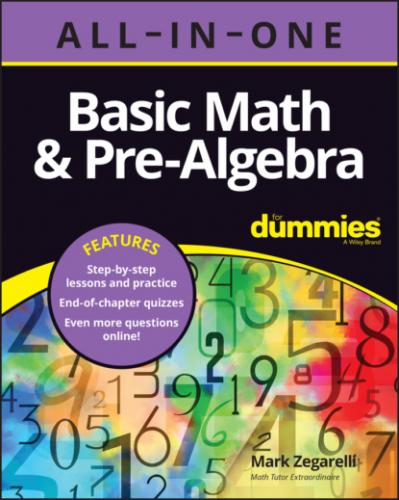In this chapter, you work with negative numbers — that is, numbers that are less than zero. To begin, you see how negative numbers arise when you subtract a smaller number minus a greater one. Next, you discover how to negate a number by flipping its sign. You also work with absolute value, which is the positive value of a number.
When you’re comfortable working with negative numbers, you begin to use them with the Big Four operations — addition, subtraction, multiplication, and division.
Understanding Where Negative Numbers Come From
When you first discovered subtraction, you were probably told that you can’t take a small number minus a greater number. For example, if you start with four marbles, you can’t subtract six because you can’t take away more marbles than you have. This rule is true for marbles, but in other situations, you can subtract a big number from a small one.
In real-world applications, negative numbers can represent debt. For example, if you have only five chairs to sell but a customer pays for eight of them, you owe them three more chairs. Even though you may have trouble picturing −3 chairs, you still need to account for this debt, and negative numbers are the right tool for the job.
As another example, if you have $4 and you buy something that costs $6, you end up with less than $0 dollars — that is, −$2, which means a debt of $2.
A number with a negative sign in front of it, like −2, is called a negative number. You call the number −2 either negative two or minus two. Negative numbers appear on the number line to the left of 0, as shown in Figure 4-1.
FIGURE 4-1: Negative numbers on the number line.
A. −3. On the number line, 5 − 8 means
Q. What is
A. −8. Because 11 is less than 19, subtract
1
(a)
(b)
(c)
(d)
2 Find the answers to the following subtraction problems:
(a)
(b)
(c)
(d)
Sign-Switching: Understanding Negation and Absolute Value
Attaching a negative sign to a positive number makes it negative.
Attaching a negative sign to a negative number makes it positive. The two adjacent (side-by-side) negative signs cancel each other out.
Attaching a negative sign to 0 doesn’t change its value, so .
In contrast to negation, placing two bars around a number gives you the absolute value of that number. Absolute value is the number’s distance from 0 on the number line — that is, it’s the positive value of a number, regardless of whether you started out with a negative or positive number:
The absolute value of a positive number is the same number.
The absolute value of a negative number makes it a positive number.
Placing absolute value bars around 0 doesn’t change its value, so .
Placing a negative sign outside absolute value bars gives you a negative result — for example, .
A. −7. Negate 7 by attaching a negative sign to it: −7.
Q. Find the negation of −3.
A. 3. The negation of
Q. What’s the negation of
